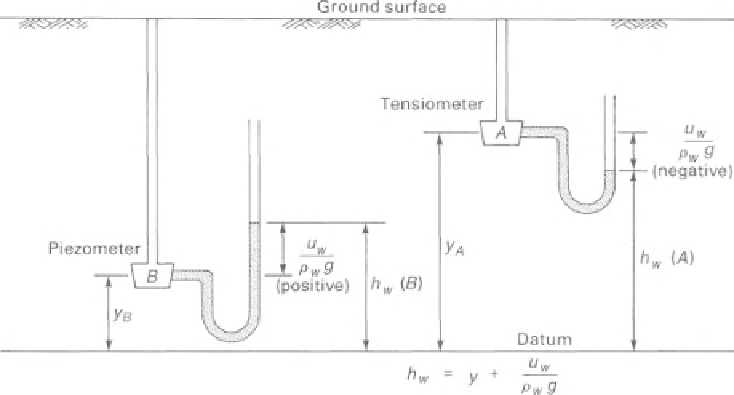Environmental Engineering Reference
In-Depth Information
The total energy at point
A
can be expressed as energy per
unit weight, which is called a potential or a hydraulic head.
The hydraulic head
h
w
at point
A
is obtained by dividing
the total energy by the unit weight of water at point
A
(i.e.,
M
w
g
):
the pore-water pressure when the pressure is negative (e.g.,
point
A
in Fig. 7.5).
The water level in the measuring device will rise or drop,
depending upon the pore-water pressure at the point under
consideration. For example, the water level in the piezometer
can rise above the elevation of point
B
a distance equal to the
positive pore-water pressure head at point
B
. The water level
in the tensiometer can alternatively drop below the elevation
of point
A
a distance equal to the negative pore-water pres-
sure head at point
A
. The distance between the water level
in the measuring device and the datum is the sum of the
gravitational and pressure heads (i.e., the hydraulic head).
In Fig. 7.5, point
A
has a higher total head than point
B
[i.e.,
h
w
(A)
>
h
w
(B)
]. Water will flow from point
A
to
point
B
due to the total head gradient between these two
points. The driving potential causing flow in the water phase
has the same form for both saturated soils (i.e., point
B
) and
unsaturated soils (i.e., point
A
) (Freeze and Cherry, 1979).
Water will flow from a point of high total head to a point of
low total head, regardless of whether the pore-water pres-
sures are positive or negative.
Osmotic suction has sometimes been included as a com-
ponent in the total head equation for water flow. However, it
is better to visualize the osmotic suction gradient as an inde-
pendent driving potential for the osmotic diffusion process
(Corey and Kemper, 1961). Osmotic diffusion is a process
where ionic or molecular constituents move as a result of
their kinetic activity. An osmotic gradient across a semiper-
meable membrane causes the movement of water through
the membrane. On the other hand, the bulk flow of solu-
tions (i.e., pure water and dissolved salts) in the absence
of a semipermeable membrane is governed by the hydraulic
head gradient. Therefore, it is better to analyze bulk flow of
water separately from the osmotic diffusion process since
the two mechanisms are independent (Corey, 1977).
v
w
2
g
u
w
ρ
w
g
+
h
w
=
y
+
(7.7)
where:
h
w
=
total energy head.
The total energy head consists of three components,
namely, the gravitational head
y
, the pressure head
(
u
w
/
ρ
w
g
), and the velocity head (
v
w
/2
g
). The velocity head
in a soil is negligible in comparison with the gravitational
and the pressure heads. The hydraulic head at any point
in the soil mass is generally written as the addition of the
gravitational head and the water pressure head, as shown
in the following equation:
u
w
ρ
w
g
h
w
=
y
+
(7.8)
The components of hydraulic head have the dimension
of length. Hydraulic head is a measurable quantity and the
difference in hydraulic head between two points provides a
gradient value that describes the available energy to cause
water flow in saturated and unsaturated soils. Devices such
as piezometers and tensiometers can be used to measure the
in situ pore-water pressure at a point (Fig. 7.5). The distance
between the elevation of the point under consideration and
the datum indicates the elevation head (i.e.,
y
A
and
y
B
).
A piezometer can be used to measure the pore-water pres-
sure at a point when the pore-water pressure is positive (e.g.,
point
B
in Fig. 7.5). A tensiometer can be used to measure
Figure 7.5
Hydraulic head as water phase driving potential for saturated and unsaturated soils.












Search WWH ::

Custom Search